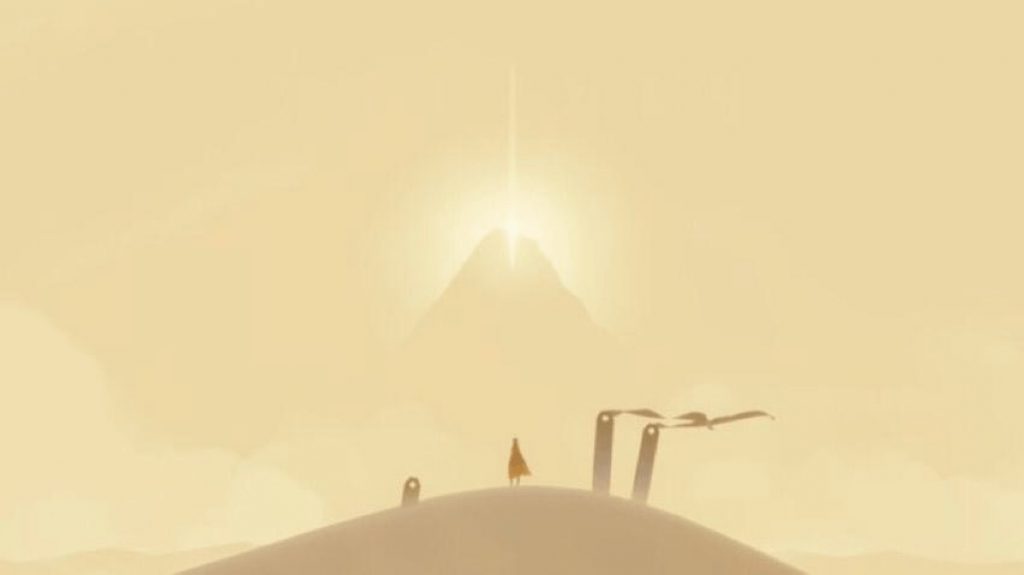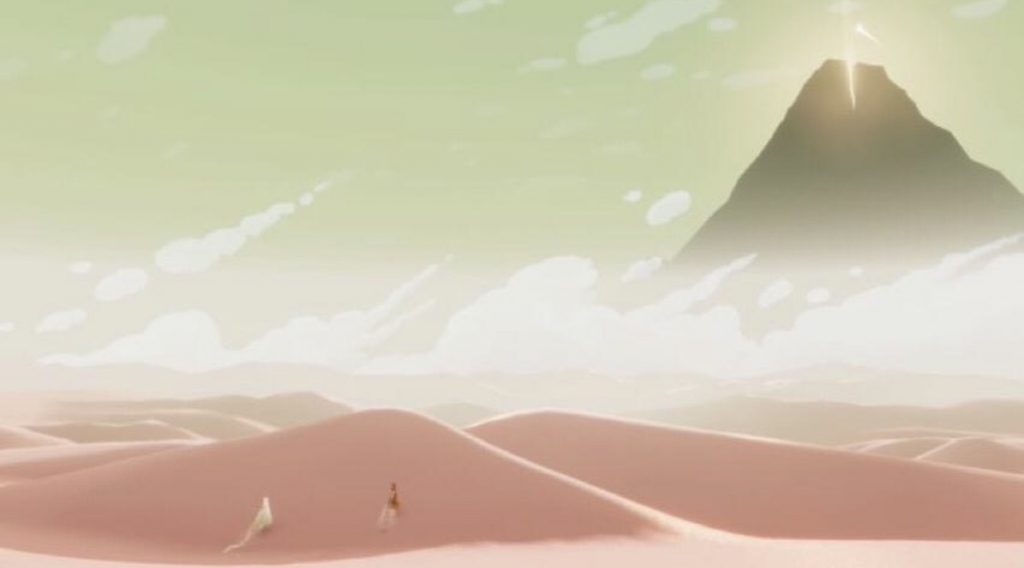Journey: Turning 10 ¦ The Most Important Indie
Sean Smith reviews the classic Indie adventure game;Journey on its 10th Anniversary, and reviews the fantastic soundtrack that accompanies the game!
Out from beneath the golden glimmer of a sand dune yawns the morning sun, letting the sands twinkle and glitter like diamonds. Out amongst the rolling dunes that glow gold and silver, a solitary figure. It shares features of a human, and yet it dons an elaborate, bohemian cloak.
Their head is bowed, as if in meditation – a long scarf is wrapped about them, glowing, suggesting its importance, and then their eyes open. Up high and far off in the distance, the glow of an immense mountain, its peak split to allow some mysterious light. The camera shifts, and with it, you are this mysterious figure, and the mountain your objective. And thus Journey begins.
These opening moments, punctuated by Austin Wintory’s now iconic soundtrack, make Journey so beautiful. The little moments of reflection, of quietness, and then subsequent grandeur. The sweeping valleys, the endless dunes, the frosted peaks.
These constant moments of beauty flow together, andare an essential reason as to why Journey has become so timeless in its design. Released in 2012, Journey appeared during the early years of true ‘indie’ developers – Minecraft had only released three years prior, and the pot of small developers was starting to stir, one such being ThatGameCompany, hopping from their tiny successes such as Flow and Flower (both which are remarkable emotional journeys in themselves).
Journey’s impact was immediate; rave reviews appeared from every corner, celebrating its beautiful art style and its emotional story (more on that later). The following year, it managed to pull in not just one BAFTA, not two, but four, and was even nominated for best game.
Nobody had seen a game of such tenderness and beauty before; 2012 was a sort of hangover from the height of the shooter game era, and everyone was hungry for some new evolution. Minecraft was gradually growing in popularity, and indie horrors were becoming an in-and-out phase, and then, from out of nowhere, came a story about connection, teamwork and faith from a tiny studio of 18 developers.

For each person, Journey means something different – without much of a plot, the game relies on a personalised response from the player. For me, I played it when I needed it the most, just as the pandemic rolled in.
It was May 2020, and I was still firmly stuck at home with my family; Journey was lodged at the back of my ‘to-play’ library for God knows how long. So I decided to play it. The magnificent opening of Austin Wintory’s sombre soundtrack sets the tone, and thus I spent the next 2 hours soaring around and having such an immense journey that by the end, it almost brought a tear to my eye.
What made this experience so intoxicating wasn’t the visuals, nor the environments, not even the music, as the reviewers had stated, no. Instead, it was the bond I had made with another person in the game.
You see, Journey is a game of bonding and teamwork, well before Kojima’s self-proclaimed ‘strand-type’ games; here, you play with another real person, unnamed and unvoiced. Neither of you can communicate, besides a single button press that makes variable sounds, and yet the connection I made was priceless. You both have the same objective, and thus travel together, from the lowest hills to the highest peak.
Whenever I had to go downstairs to help my mum with something, I’d come back, and my nameless friend would still be there, sitting beside me until I returned. In our journey, they’d call out to me – a small blip-blip – to show me another secret, another collectible, as if they knew I was an eager completionist.
Those sweet moments, of flying about with your magical scarf, and sharing a quiet moment of fun is what makes Journey so endearing. And the multiplayer elements aren’t simply emotion fodder – you can also support one another, shouting out to each other to refuel your magical scarfs, and to protect each other in colder environments.
The unsaid teamwork, and the bond you make with your fellow companion, is unlike anything in a videogame before or since; its simple purity is wonderful to play.

During my time playing Journey, I felt a pang of warmth, in a time when things were at their most uncertain, and even now, where teamwork, faith and community as important as ever, pieces of art such as Journey, remind us of their vitalness to all life.
Without delving too much into the ending, getting to see the username of those who helped you on your travels is a beautiful thing; aptly enough, the very person I travelled with messaged me after and thanked me for such a wonderful journey.
I had made a small friend, for a flickering moment, and that was all I needed at a time when I had felt the loneliest.
To say Journey’s influence was significant would not do justice to just how much is has marked the artistic world of videogames – from spawning endless, and sometimes quite good, clones of its formula, to promoting the world of indie as a development format, Journey has had a resounding effect. And not only on the industry, but on us as gamers as well; and for those who have yet to try it, I would seriously emphasise giving it a try, and its sequel, Sky: Children of the Light.
Both are enlightening and heart-warming, and a treat to even the most amateur of gamers.